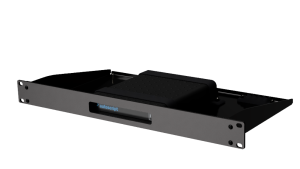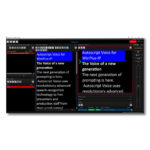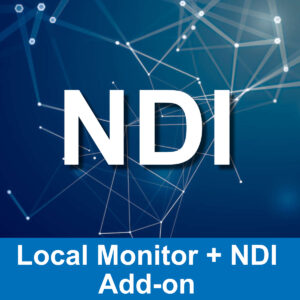Do you have any questions?
We will be happy to help you.
Autoscript WinPlus-IP AI Voice Presenter Add-On
WinPlus-IP Voice FAQs
How does WP-IP Voice differ from other voice recognition systems?
Advanced speech recognition (ASR) can be found in many products today, from phones to cars. However, the voice control of teleprompters requires a significantly higher level of functionality that is specially tailored to complex live situations.
The engineers at Autoscript have risen to this challenge and developed a voice control system that meets the requirements in terms of both accuracy and responsiveness. This was achieved by implementing proprietary algorithms with advanced pattern matching on a specially developed, sophisticated ASR system. The development was optimized in cooperation with NBC News.
The result is a prompter speech recognition system that is unrivaled in terms of reliability, flexibility and user-friendliness and does not reach its limits even with complex transmission sequences.
How reliable is Autoscript Voice Prompting?
As a leading provider of prompting solutions, Autoscript understands that the reliability of a teleprompter system is essential.
To ensure this, the company has used beta testing as an important part of the development of the WinPlus-IP Voice Add-On.
These tests were carried out under real conditions and with different languages in order to optimize the performance of the system.
These efforts have paid off: Today, voice prompting is used daily in live news and magazine broadcasts.
In Germany, rbb Berlin was the first broadcaster to implement voice prompting together with Progl+Gerlach.
This proves that the WinPlus-IP Voice Add-On is a reliable and powerful solution for the requirements of live broadcasts.
Can voice input be used in parallel with a controller?
Yes, the voice input of WinPlus-IP Voice is designed to function like an additional controller within the system.
WinPlus-IP Voice follows the standard controller convention where the last prompter controller used is the active controller.
This allows you to switch seamlessly between voice control and hand or foot scroll control at any time. This enables flexible and intuitive control of the prompter, giving you maximum control and adaptability.
Can a moderator speak freely (adlib) while WP-IP Voice controls his prompter text?
Yes, because WinPlus-IP Voice uses advanced advanced speech recognition to recognize spoken words and follow the script, the system can recognize when a presenter leaves the script and speaks freely.
Speech recognition is programmed so that scrolling is automatically paused as long as the speaker does not return to the script. This ensures that the scrolling is always synchronized with the speaker and guarantees an uninterrupted presentation.
This feature allows presenters to focus on the content and not concentrate on controlling the prompter, which improves the overall presentation.
How does WP-IP Voice handle non-scripted segments such as SOTs, VTRs and interviews?
The artificial “prompter intelligence” developed and integrated into WinPlus-IP Voice by Autoscript engineers enables comprehensive handling of all production processes.
For example, Voice automatically scrolls through SOT descriptions, sluglines and other non-script-related content if it is not stored as a script.
In interview situations, Voice supports the moderator by displaying the next questions and allows the director to intervene if required. This functionality increases the efficiency and flexibility of the prompter and thus helps to improve production processes.
Can Voice IP be used in a virtualized production environment?
Yes, just like WinPlus-IP, WinPlus-IP Voice is able to run on a virtual machine.
This is an important requirement for many transmitters and has been thoroughly tested to ensure reliable operation in everyday transmitter use.
This enables users to benefit from the advantages of virtualization and to make their IT infrastructure more flexible and adaptable.









